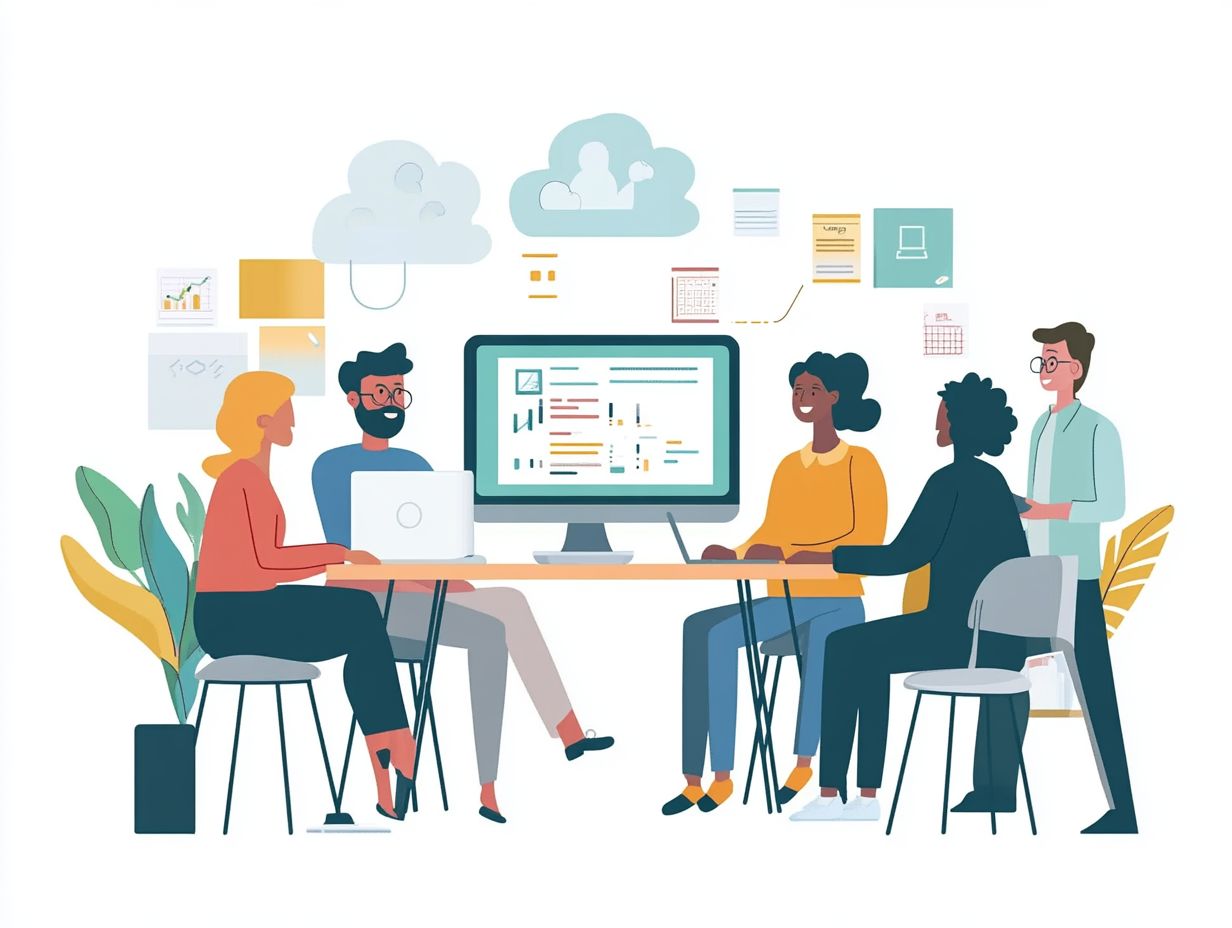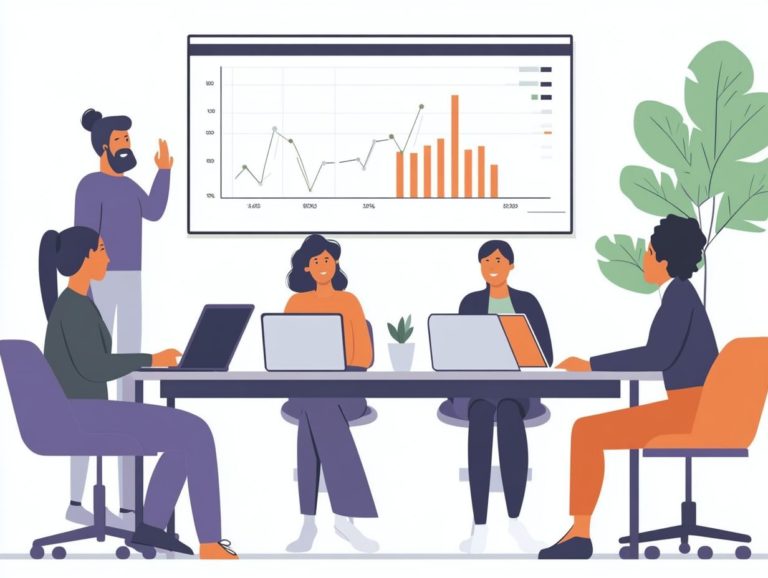The Benefits of SaaS for Nonprofits
In an increasingly digital landscape, you ll find that nonprofits are tapping into the transformative power of Software as a Service (SaaS). This approach doesn t just streamline operations; it also unlocks advanced technology that can significantly enhance how well you run your organization.
Before you leap into the world of SaaS, it’s essential to consider key factors like compatibility and data security. This article reveals how SaaS can transform your nonprofit. You’ll find practical tips and inspiring success stories inside!
Don t wait discover how your organization can thrive with SaaS today!
Contents
- Key Takeaways:
- Advantages of Using SaaS for Nonprofits
- Key Considerations Before Adopting SaaS for Nonprofits
- Best Practices for Implementing SaaS
- Success Stories of Nonprofits Using SaaS
- Preguntas Frecuentes
- Qu es SaaS y c mo puede beneficiar a las organizaciones sin fines de lucro?
- C mo puede SaaS ayudar a las organizaciones sin fines de lucro a ahorrar dinero?
- Cu les son los beneficios de escalabilidad de SaaS para las organizaciones sin fines de lucro?
- Puede SaaS ayudar a las organizaciones sin fines de lucro a estar al d a con la ltima tecnolog a?
- Existen preocupaciones de seguridad al usar SaaS para organizaciones sin fines de lucro?
- C mo pueden las organizaciones sin fines de lucro asegurar una transici n suave a SaaS?
Key Takeaways:

SaaS helps nonprofits save money and increase efficiency by eliminating the need for expensive hardware and software. Before adopting SaaS, nonprofits should ensure data security and privacy measures are in place.
What is SaaS and How Does it Work?
Software as a Service (SaaS) marks a significant transformation in how you access and leverage technology. This cloud-based model means you can access software over the internet instead of installing it on your computer. It eliminates the hassle of local installations and slashes costs tied to traditional software management.
SaaS solutions meet various needs. They enhance accessibility and collaboration while ensuring scalability to serve diverse communities effectively.
The power of SaaS is amplified through automation. It equips you with tools to streamline workflows, boost donor engagement, and create impactful results through data-driven insights.
By operating within a cloud computing framework, SaaS offers you unmatched flexibility and creates an environment where collaboration can flourish. You can seamlessly adopt these systems without facing hefty upfront investments.
With the ability for seamless integration with other software solutions, SaaS stands out as an invaluable asset for nonprofit organizations aiming to harness technology effectively.
As you face challenges of doing more with limited resources, the scalability that SaaS provides enables you to expand your services and amplify your impact as your needs evolve. In today’s digital landscape, SaaS isn’t just an option; it’s a vital resource that can elevate your organization’s mission.
Advantages of Using SaaS for Nonprofits
SaaS presents a wealth of advantages for nonprofits, equipping you with tools that significantly enhance efficiency, collaboration, and resource management.
By embracing cloud-based solutions, your organization can streamline workflows, elevate donor engagement, and ensure effective allocation of funds while adeptly responding to community needs.
Cost Savings and Efficiency
One of the primary benefits of adopting SaaS for nonprofits is the remarkable cost savings that stem from reduced infrastructure compared to traditional software solutions. By using cloud technology, your organization can significantly cut down on expenses associated with hardware maintenance.
This transition enables you to redirect those saved funds toward mission-critical initiatives rather than IT upkeep. With the ability to manage resources and streamline operations, your organization can boost its efficiency, ultimately enhancing donor engagement.
Thanks to improved communication tools and data analytics offered by SaaS, you can develop more personalized outreach strategies. This allows you to appeal to donors in a more effective manner. The financial benefits extend beyond simple savings; they cultivate a more impactful use of funding, enabling your organization to broaden its outreach and expand its programs.
Access to Advanced Technology
SaaS (Software as a Service) enables you, as a nonprofit, to access advanced technology that was once restricted to larger organizations, making software solutions accessible to everyone. With cloud-based platforms at your fingertips, even small nonprofits can use powerful tools for data analysis, automation, and collaboration. This significantly enhances your operational capabilities.
For example, platforms like Salesforce Nonprofit Cloud and HubSpot for Nonprofits offer robust customer relationship management features. These tools help you track donor interactions and manage fundraising campaigns more efficiently.
Tools like QuickBooks Online simplify financial management. Meanwhile, Mailchimp allows you to run effective email marketing campaigns that engage supporters and raise awareness.
By harnessing these innovative applications, gather data insights to make better decisions and automate routine tasks. This frees up valuable time to focus on what truly matters advancing your mission.
Key Considerations Before Adopting SaaS for Nonprofits

While SaaS offers many advantages for nonprofits, carefully weigh several critical considerations before transitioning to cloud-based solutions.
Evaluate how compatible these platforms are with your existing systems and review their data security measures and compliance requirements. Ensuring these factors align with your operational goals and the unique needs of your community is key to a successful transition.
Evaluating Compatibility
Assessing the compatibility of SaaS solutions with your current systems is essential for a seamless transition. Integrating cloud-based technology with your existing software enhances user experience and keeps workflows running smoothly, benefiting both your staff and stakeholders.
This step is crucial; misalignment can lead to inefficiencies, data silos, and frustration among your team members. Nonprofits often face challenges like limited budgets or outdated infrastructure, complicating the integration process.
To tackle these issues, conduct thorough compatibility assessments. Consider solutions such as phased rollouts or customized training sessions.
By planning your integration efforts strategically, you can minimize disruptions while maximizing the potential of your newly adopted technologies. This fosters a more resilient and agile operational environment.
Understanding Data Security
Data security and privacy should be top priorities for you as a nonprofit when considering SaaS solutions, especially since you’re often handling sensitive information related to donors and community members. Ensuring compliance with relevant regulations is essential for building trust and maintaining your organization s positive reputation.
You ll need to navigate a complex web of regulations, including GDPR and HIPAA, which require strict data protection standards. Implementing strong security protocols, like encryption and regular audits, not only protects sensitive data but also aligns with best practices in risk management.
Regular training for your staff on data handling and privacy practices will enhance your compliance efforts. Partnering with reputable SaaS providers that offer robust security measures and transparent privacy policies can effectively mitigate risks and assure stakeholders that their data is secure.
Taking a proactive approach to data management fosters a culture of privacy that benefits both your organization and its constituents.
Best Practices for Implementing SaaS
Implementing SaaS effectively involves embracing best practices that maximize your investment in cloud-based solutions.
From selecting the right provider to ensuring comprehensive training and ongoing support for your staff, these strategies greatly enhance both user experience and operational efficiency.
By focusing on these key elements, position your nonprofit for success and unlock the full potential of your technology.
Choosing the Right Provider
Selecting the right SaaS provider is crucial for your nonprofit, as this partner will significantly influence your organization s ability to meet its goals. Assess potential providers based on their offerings, support services, and how well they align with your nonprofit s mission and community needs.
For example, when evaluating your options, consider providers like Salesforce.org. They offer a comprehensive suite of tools specifically designed for social impact, including effective donor management and community engagement functionalities.
Another strong contender is TechSoup, renowned for its extensive support resources and deep commitment to nonprofit clients.
It s vital that the provider you choose not only offers robust software solutions but also fosters a genuine partnership by understanding and supporting your unique challenges. Prioritizing ongoing customer support and continuous updates can be game-changers, ensuring that your organization remains agile in its mission-driven efforts.
Training and Support for Staff

Effective training and support for your staff are essential elements of a successful SaaS implementation. Ensuring that users feel comfortable with new tools and technologies is paramount. As a nonprofit, prioritize training programs that meet diverse user needs. This enhances user experience and boosts productivity.
These programs can include everything from in-person workshops to online tutorials, providing you with the flexibility to accommodate various learning styles. By incorporating interactive elements like quizzes and hands-on activities, you can further engage your team and solidify their understanding of the software.
Ongoing support is equally important; accessible resources such as a dedicated help desk or an online knowledge base can reinforce learning and build confidence. Regular feedback sessions will help you identify areas for improvement, making it easier to customize future training initiatives.
By investing in staff training and support, you not only maximize the benefits of your SaaS tools but also cultivate a more agile and effective workforce.
Success Stories of Nonprofits Using SaaS
Countless nonprofits have skillfully harnessed SaaS solutions to elevate their operations and create substantial impact within their communities.
These compelling success stories showcase how technology can foster collaboration, enhance donor engagement, and enable organizations to achieve their missions with greater efficacy.
Real-Life Examples of Benefits and Impact
Real-life examples of nonprofits leveraging SaaS solutions reveal the significant benefits and impacts that technology can bring. These organizations have successfully transformed their workflows, enhanced collaboration, and improved donor engagement, positioning themselves for greater success in achieving their missions.
Consider the American Red Cross, which embraced an online donor management system not just to optimize donor management but also to enable real-time updates during disaster response efforts.
Similarly, the World Wildlife Fund has implemented SaaS tools for project management, fostering better team coordination across its global offices.
As a result, these nonprofits have experienced notable increases in volunteer engagement and fundraising efficiency, enabling them to create a tangible difference in their communities.
By harnessing such innovative solutions, they have transformed their operations, allowing for more agile responses to urgent social issues.
Preguntas Frecuentes
Qu es SaaS y c mo puede beneficiar a las organizaciones sin fines de lucro?
SaaS significa Software como Servicio, que es un modelo de entrega de software donde el software se aloja en un servidor remoto y se accede a trav s de internet. Este modelo ofrece numerosos beneficios para las organizaciones sin fines de lucro, incluyendo ahorro de costos, escalabilidad y f cil acceso a la ltima tecnolog a.
C mo puede SaaS ayudar a las organizaciones sin fines de lucro a ahorrar dinero?

Con SaaS, las organizaciones sin fines de lucro no necesitan gastar mucho en computadoras ni en licencias de software. Solo pagan por lo que usan mediante suscripciones, lo que les ayuda a ahorrar en gastos iniciales!
Los proveedores de SaaS tambi n ofrecen descuentos especiales para organizaciones sin fines de lucro, lo que lo convierte en una opci n a n m s accesible.
Cu les son los beneficios de escalabilidad de SaaS para las organizaciones sin fines de lucro?
SaaS permite a estas organizaciones aumentar o disminuir su uso de software seg n cambien sus necesidades. Pueden agregar o quitar usuarios o funciones sin invertir en nuevo hardware.
Esto es especialmente til para organizaciones que enfrentan cambios en sus recursos o demanda.
Puede SaaS ayudar a las organizaciones sin fines de lucro a estar al d a con la ltima tecnolog a?
Claro! Los proveedores de SaaS se encargan de actualizar y cuidar el software. As , las organizaciones siempre tienen acceso a la tecnolog a m s reciente.
Esto les permite enfocarse en su misi n en lugar de preocuparse por el mantenimiento del software.
Existen preocupaciones de seguridad al usar SaaS para organizaciones sin fines de lucro?
Si bien es fundamental elegir un proveedor de SaaS confiable, este tipo de software puede ofrecer una mayor seguridad. Los proveedores suelen contar con equipos de TI y medidas de protecci n m s robustas que las que una organizaci n podr a permitirse por s sola.
C mo pueden las organizaciones sin fines de lucro asegurar una transici n suave a SaaS?
Para una transici n efectiva, deben investigar y escoger un proveedor de confianza. Tambi n es crucial comunicar el cambio al personal y proporcionar la capacitaci n necesaria.
Comenzar con un programa piloto es una excelente idea antes de hacer la transici n completa a SaaS.






